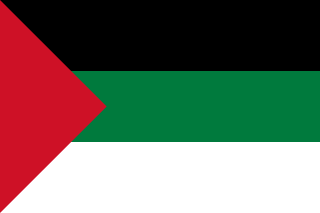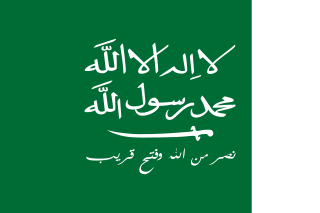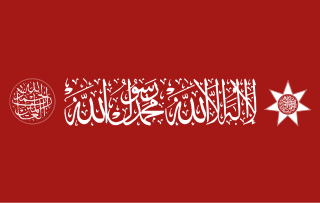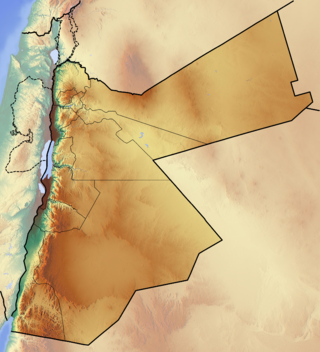
The Hejaz is a region that includes the majority of the west coast of Saudi Arabia, covering the cities of Mecca, Medina, Jeddah, Tabuk, Yanbu, Taif and Baljurashi. It is thus known as the "Western Province", and it is bordered in the west by the Red Sea, in the north by Jordan, in the east by the Najd, and in the south by the Region of 'Asir. Its largest city is Jeddah, which is the second-largest city in Saudi Arabia, with Mecca and Medina, respectively, being the fourth- and fifth-largest cities in the country.

Abdulaziz bin Abdul Rahman Al Saud, known in the West as Ibn Saud, was an Arab political and religious leader who founded Saudi Arabia – the third Saudi state – and reigned as its first king from 23 September 1932 until his death in 1953. He had ruled parts of the kingdom since 1902, having previously been Emir, Sultan, and King of Nejd, and King of Hejaz.

The Hashemite Kingdom of Hejaz was a state in the Hejaz region of Western Asia that included the western portion of the Arabian Peninsula that was ruled by the Hashemite dynasty. It was self-proclaimed as a kingdom in June 1916 during the First World War, to be independent from the Ottoman Empire, on the basis of an alliance with the British Empire to drive the Ottoman Army from the Arabian Peninsula during the Arab Revolt.

The Saudi–Yemeni War was a war between Saudi Arabia and the Kingdom of Yemen in 1934.
The Battle of Jeddah or the siege of Jeddah took place in 1925, as part of the Ibn Saud's campaign to conquer the Kingdom of Hejaz. Jeddah was the last major stand of the Hashemites against the Saudis.

The Unification of Saudi Arabia was a military and political campaign in which the various tribes, sheikhdoms, city-states, emirates, and kingdoms of most of the central Arabian Peninsula were conquered by the House of Saud, or Al Saud. Unification started in 1902 and continued until 1932, when the Kingdom of Saudi Arabia was proclaimed under the leadership of Abdulaziz, known in the West as Ibn Saud, creating what is sometimes referred to as the Third Saudi State, to differentiate it from the Emirate of Diriyah, the First Saudi State and the Emirate of Nejd, the Second Saudi State, also House of Saud states.
The Battle of Mecca took place on 5 December 1924 in Mecca, as part of the Saudi conquest of the Kingdom of Hejaz by King Abdulaziz Ibn Saud of the Sultanate of Nejd. The Hejaz region was ruled as a kingdom under King Hussein bin Ali of the Hashemite family. The battle in Mecca resulted in a Hashemite defeat to the Saudis and the allied Ikhwan fighters.

The Kingdom of Hejaz and Nejd, initially the Kingdom of Hejaz and Sultanate of Nejd, was a dual monarchy ruled by Abdulaziz following the victory of the Saudi Sultanate of Nejd over the Hashemite Kingdom of the Hejaz in 1925. It was the fourth iteration of the Saudi State.

This is a survey of the postage stamps and postal history of Saudi Arabia, formerly known as the Kingdom of Hejaz and Nejd until 22 September 1932. The Kingdom of Hejaz and Nejd had been separate countries until the mid-1920s.

The Sharifate of Mecca or Emirate of Mecca was a state, non-sovereign for much of its existence, ruled by the Sharif of Mecca. A sharif is a descendant of Hasan ibn Ali, Muhammad's grandson. In Western sources, the prince of Mecca was known as Grand Sherif, but Arabs have always used the appellation "Emir".

The Ikhwan revolt was an uprising in the Arabian Peninsula from 1927 to 1930 led by the Ikhwan. It began in 1927, when the tribesmen of the Otaibah, Mutayr and Ajman rebelled against the authority of Ibn Saud and engaged in cross-border raids into parts of Transjordan, Mandatory Iraq and the Sheikhdom of Kuwait. The relationship between the House of Saud and the Ikhwan deteriorated into an open bloody feud in December 1928. The main instigators of the rebellion were defeated in the Battle of Sabilla, on 29 March 1929. Ikhwan tribesmen and troops loyal to Abdulaziz clashed again in the Jabal Shammar region in August 1929, and Ikhwan tribesmen attacked the Awazim tribe on 5 October 1929. Faisal Al Dawish, the main leader of the rebellion and the Mutair tribe, fled to Kuwait in October 1929 before being detained by the British and handed over to Ibn Saud. Faisal Al-Dawish would die in Riyadh on 3 October 1931 from what appears to have been a heart condition. Government troops had finally suppressed the rebellion on 10 January 1930, when other Ikhwan rebel leaders surrendered to the British. In the aftermath, the Ikhwan leadership was slain, and the remains were eventually incorporated into regular Saudi units. Sultan bin Bajad, one of the three main Ikhwan leaders, was killed in 1931, while Al Dawish died in prison in Riyadh on 3 October 1931.
The Saudi conquest of Hejaz or the Second Saudi-Hashemite War, also known as the Hejaz-Nejd War, was a campaign engaged by Saudi Sultan Abdulaziz to take over the Hashemite Kingdom of Hejaz in 1924–25, ending with conquest and incorporation of Hejaz into the Saudi domain.
The Taif massacre was an incident that followed the short 1924 Battle of Taif; the entire episode is also known as the al-Taif incident. The battle and resultant massacre comprised the first major standoff of the Second Hashemite-Saudi War. Following a short siege, the city was abandoned by Hashemite forces and then capitulated to the battle-ready Ikhwan force under the command of Abdulaziz Ibn Saud. The Ikhwan troops took out their rage on the residents of the city. In the resulting bloodbath, some 300-400 Ta'if residents were massacred.
The First Saudi–Hashemite War, also known as the First Nejd–Hejaz War or the al-Khurma dispute, took place in 1918–19 between Abdulaziz Ibn Saud of the Emirate of Nejd and Hasa and the Hashemites of the Kingdom of Hejaz.

The Treaty of Darin, or the Darin Pact, of 1915 was made between the United Kingdom and Abdulaziz Al Saud, ruler of the Emirate of Nejd and Hasa, who founded the Kingdom of Saudi Arabia in 1932.

The King of Saudi Arabia, officially the King of the Kingdom of Saudi Arabia, is the monarch and head of state/government of the Kingdom of Saudi Arabia who holds absolute power. He is the head of the Saudi Arabian royal family, the House of Saud. The king is the supreme commander-in-chief of the Royal Saudi Armed Forces and the head of the Saudi national honors system. The king is called the "Custodian of the Two Holy Mosques", a title that signifies Saudi Arabia's jurisdiction over the mosques of Masjid al-Haram in Mecca and Al-Masjid an-Nabawi in Medina. The title has been used many times through the history of Islam. The first Saudi king to use the title was Faisal; however, King Khalid did not use the title after him. In 1986, King Fahd replaced "His Majesty" with the title of Custodian of the Two Holy Mosques, and it has been since used by both King Abdullah and King Salman. The king has been named the most powerful and influential Muslim and Arab leader in the world according to the Muslim 500.

The Hejaz Air Force or Hejaz Flying Corps was the aerial component of the armed forces of the short-lived Kingdom of Hejaz and its successor the Kingdom of Hejaz and Nejd. Claiming to be the oldest Air Force on the Arabian Peninsula, the service was a very small entity, numbering at most nine aircraft at any time. It operated intermittently between 1921 and 1932, battling with staff shortages and aircraft availability; often only two aircraft were operational at any time. The personnel came from many nations, with pilots coming from Germany, Greece, Italy, Russia and the United Kingdom, as well as from the kingdom itself after the flight of the first Arab pilot, Abdul Salam Sarhan, in 1923. It provided aerial reconnaissance and bombardment to support the army against the much larger land forces of Ibn Saud during the Hejaz-Nejd War, including bombing attacks on Jeddah and Mecca. Its successor is the Royal Saudi Air Force.

The Jordan–Saudi Arabia border is 731 km (454 mi) in length and runs from the Gulf of Aqaba in the south-west to the tripoint with Iraq in the north-east.

The Declaration of theUnification of Saudi Arabia was officially announced by Prince Faisal bin Abdulaziz, the Viceroy of Hejaz on behalf of King Abdulaziz ibn Saud on September 23, 1932, at 9:00 am from al-Hamidiyah Palace in Mecca. Faisal read out the Royal Decree No. 2716 issued by Abdulaziz ibn Saud on September 18, 1932, that renamed the Kingdom of Hejaz and Nejd and its annexes as the Kingdom of Saudi Arabia.

The Second Saudi-Rashidi War (1915–1918) took place between the British-aligned Emirate of Nejd and Hasa and the Emirate of Jabal Shammar, which was an ally of the Ottoman Empire.














